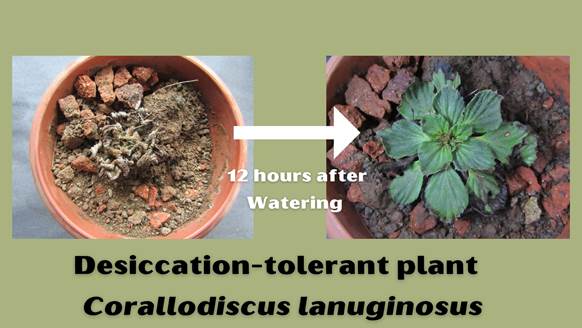The Western Ghats in India, recognized as a biodiversity hotspot, harbors a diverse array of 62 desiccation-tolerant vascular plant species that hold promise for agricultural applications, particularly in regions facing water scarcity. Desiccation-tolerant plants possess a remarkable ability to withstand severe dehydration, losing up to 95% of their water content, and subsequently recovering when water becomes available again. This exceptional adaptation enables them to thrive in arid environments that would be inhospitable to most other plant species. Although desiccation-tolerant plants are commonly found in tropical rock outcrops, their presence and characteristics in the Western Ghats have received relatively little scientific attention.
In a recent study conducted by scientists from Agharkar Research Institute (ARI) Pune, in collaboration with Dr. Stefan Porembski from Rostock University Germany, the aim was to fill this knowledge gap. The research efforts resulted in the identification of a total of 62 desiccation-tolerant species in the Western Ghats, a substantial increase compared to the previously known nine species. Published in the Nordic Journal of Botany, the study offers an overview of desiccation-tolerant plants in India, with a specific focus on the Western Ghats, and provides an extensive inventory of species along with their preferred habitats.
Out of the 62 identified species, 16 are exclusive to India, underscoring the country’s remarkable endemism, and 12 species are found solely in the Western Ghats outcrops, underscoring the region’s global significance as a desiccation-tolerant hotspot. The study also highlights the importance of partially shaded forests, in addition to rock outcrops, as crucial habitats for desiccation-tolerant species.
To assess the desiccation tolerance of these plants, the research team conducted meticulous field observations and employed estimation protocols. The study unveiled nine newly discovered genera of desiccation-tolerant plants, including the first documented instance of an epiphytic desiccation-tolerant angiosperm, Tripogon capillatus. Furthermore, the study provides compelling field observation-based evidence regarding the desiccation-tolerant properties of the gesneriad Corallodiscus lanuginosus, which is captivatingly depicted in a time-lapse video showcasing its rehydration process.
Under the leadership of Dr. Mandar Datar, the study’s findings bear significant implications for our understanding of biodiversity and ecology in the Western Ghats, while also offering insights to aid in the conservation of desiccation-tolerant plant species. Furthermore, gaining insights into the mechanisms by which these plants endure dehydration could potentially contribute to the development of drought-resistant crops that require less water.
For further information, Dr. M. N. Datar ([email protected]), the corresponding author of the study, can be contacted at 020 25325057 or 9850057605.
Research Paper Details: Smrithy, V., Kulkarni, A., Shigwan, B. K., Porembski, S., & Datar, M. N. (2023). Desiccation‐tolerant vascular plants from Western Ghats, India: review, updated checklist, future prospects, and new insights. Nordic Journal of Botany, e03939. [Link to the research paper: https://onlinelibrary.wiley.com/doi/abs/10.1111/njb.03939]
A short video showcasing the desiccation tolerance of the plant Corallodiscus lanuginosus is available at https://youtu.be/DmCf-op_yKo, providing a captivating depiction of its time-lapse transformation during the rehydration process.





